Consumption
We measured the consumption with the useful RCE PM600, which can also measure the Cos(fi) (or power factor). The result is already given in watts.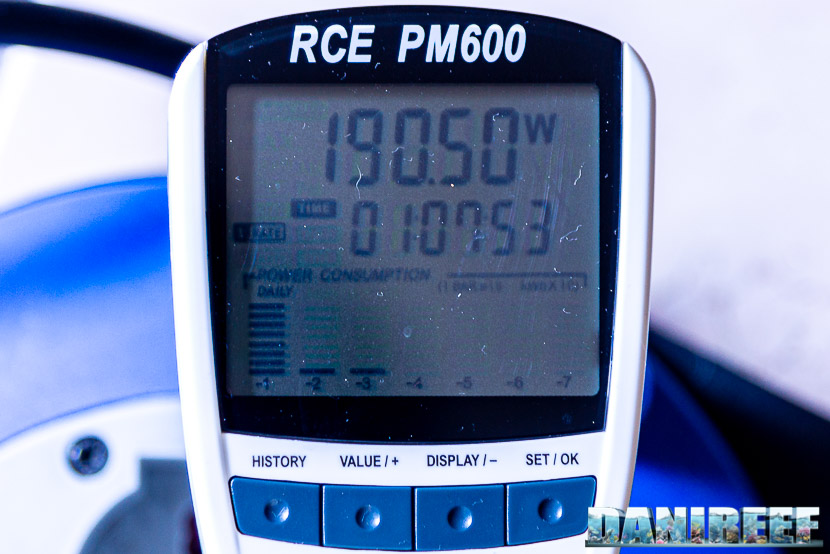
Here is how we calculated the absorbed current (the power):
Ceiling lights Philips CoralCare: 190.50 watt. Considering that at 17 cm the ceiling light has at the middle 2.088 μmol m-2 s-1, we can guess that it will have a peak value of 10.96 μmol m-2 s-1 w-1 (PAR per watt). The same value of the declared 190 w.
The cos(fi) is the same as what was declared: 0.98 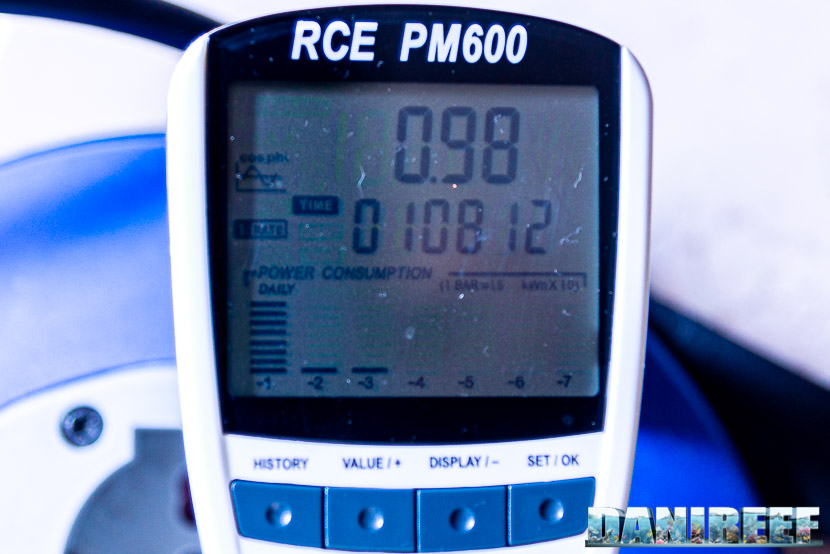
Maintenance Costs
The Philips CoralCare costs 749 euro ($827.75 USD).
The absorbed power is 190.5 watt, so the relationship cost/watt is about 3.93 euro per watt. One of the best values we have ever measured.
The comparison with the other ceiling lights on the market
We have started to use the new Quantum Meter MQ-510 di Apogee. we can’t completely compare the data of other ceiling lights, as we previously used the Seneye probe. The CoralCare is the first ceiling light to which we applied this method, so we will add many new comparisons in the next weeks. We have already measured the values of the Cetus 2, the Aqamai LRM, and the LRS. In addition, we have to think about the CoralCare as a ceiling light with diffused light, like the Orphek Atlantik V4, which we will soon test again with the new method, the GNC 466, and the Maxspect Ethereal. The Orphek registered 1,515 PAR, the GNC 696 PAR, and the Ethereal 689 PAR.
Remember that the PAR measurements were taken at 20 cm distance in air (about 17 cm real distance)
| Ceiling light | PAR | Watt | Price | PAR/watt | euro per watt |
| GNC 466 | 696 (Seneye) | 120 | 1.400 euro | 5,8 spread | 11,7 |
| Orphek Atlantik V4 | 1.515 (Apogee) | 226 | 1.099 euro | 6,7 spread | 4,9 |
| Philips CoralCare 2018 | 2.088 (Apogee) | 190 | 749 euro | 11 spread | 3,9 |
| Maxspect Ethereal | 689 (Seneye) | 130 | 500 euro | 5,3 semi spread | 3,8 |
| Led bars Askoll Pure Marine | 237 (Apogee) | 28 | n.d. | 8,4 | |
| Zetlight UFO ZE-8000 | 791 (Seneye) | 91,5 | 500 euro | 8,6 cluster | 5,5 |
| Aqamai LRM | 1.088 (Seneye) | 87,5 | 465 euro | 12,4 double cluster | 5,2 |
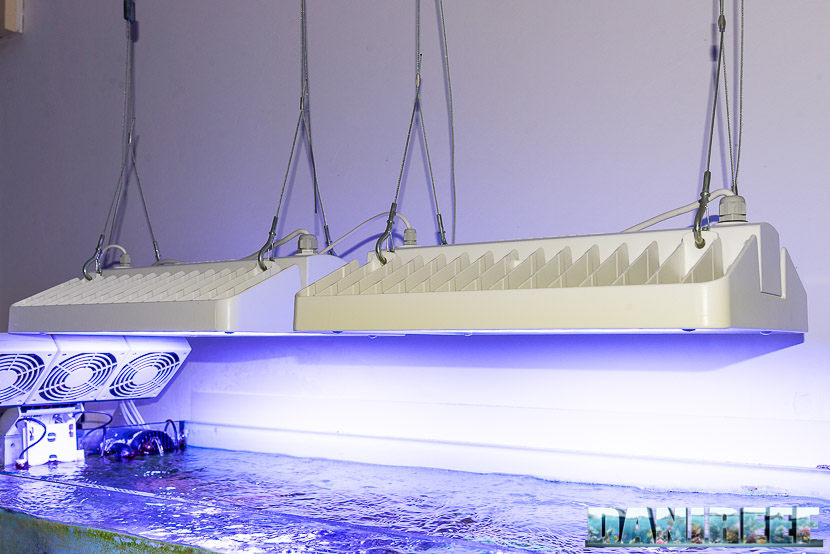 The Philips CoralCare 2018 registered the highest value we have ever seen. The best PAR per watt value was the Apogee. In term of price they’re still the best, second only to the Maxspect Ethereal.
The Philips CoralCare 2018 registered the highest value we have ever seen. The best PAR per watt value was the Apogee. In term of price they’re still the best, second only to the Maxspect Ethereal.
Maintanence costs
The absorbed power is 190 watts, so it has a cost/watt of about 3,9 euro per watt. In order to make a comparison with the orher ceiling lights you can refer to this chart:
| Ceiling light | Price | Consumption | Relationship euro per watt | |
| Philips Coralcare 2018 | 749 euro | 190 watt | 3,9 euro per watt | |
| Maxspect Ethereal | 500 euro | 126 watt | 4,0 euro per watt | |
| radion XR30w G2 PRO | 790 euro | 170 watt | 4,7 euro per watt | |
| radion XR30w G4 PRO | 915 euro | 190 watt | 4,8 euro per watt | |
| OceanLed Sunrise 600 | 870 euro | 180 watt | 4,8 euro per watt | |
| Orphek Atlantik V4 | 1099 euro | 226 watt | 4,9 euro per watt | |
| radion XR30w G2 | 690 euro | 140 watt | 4,9 euro per watt | |
| radion XR30w G4 | 760 euro | 150 watt | 5,1 euro per watt | |
| Aqamai LRM | 465 euro | 87,5 watt | 5,2 euro per watt | |
| Zetlight UFO ZE-8000 | 500 euro | 91,5 watt | 5,5 euro per watt | |
| CEAB Slide & Led | 2.700 euro | 275 watt | 9,8 euro per watt | |
| sicce GNC 466 | 1.592 euro | 120 watt | 13,3 euro per watt |
.
The ceiling light is very well built; it’s not so beautiful, but the covering is almost perfect and the application is very simple. The PAR is perfect for every coral within an area of 60×60 cm, but the covering can easily reach 80×80 cm. The cost per watt is the best among the measured ones and the PAR expressed is impressive. What else do you need?
Questions and comments, as always, are welcomed. And most of all, do you like our new measuring method? [Translated by Agnese Poggi]
Our new working method for the PAR measurement
During the long nights spent on our forum we always wondered how could we compare PAR from different ceiling lights. Even though we had the perfect device, the Quantum Meter MQ-510 di Apogee, we could only compare measurements taken at the center, at 20 cm away.
The Quantum Meter MQ-510 measures the PAR, expressed in PFFD (photosynthetic photon flux density) in μmol m-2 s-1. This device is calibrated to work underwater, so if it’s in the air, the measured value has to be divided by 1.32: the dive factor. We did all necessary conversions. The values that follow are correct. 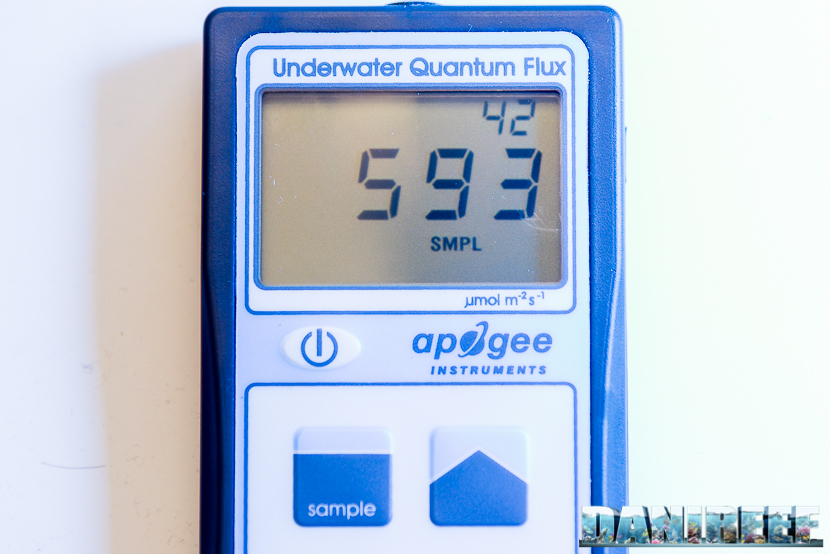
We decided to make a square base of 70×70 cm and then establish 17 fiducial points where we’d place the Quantum Meter MQ-510; we also made lifts of 20, 40, and 60 cm for the ceiling light, to have the same distance from the sensor. This will allow us to create curves in the space that can be compared to those of other ceiling lights, all at the same distances. This distance is measured from the base of the sensor to the ceiling light. Really, it should be decreased by 3.5 cm, which is the height of the measurement cylinder. 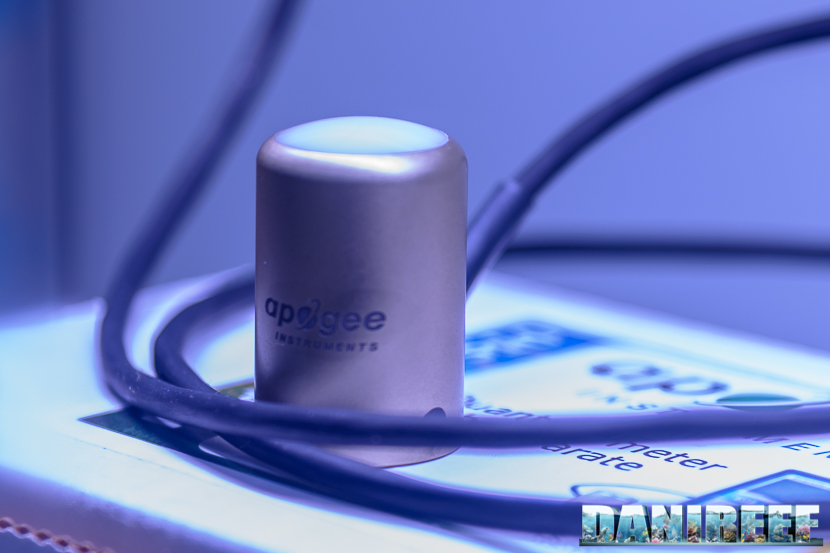
The three measurements are made at 17, 37, and 57 cm away. Because they’re done in air they will be corrected. 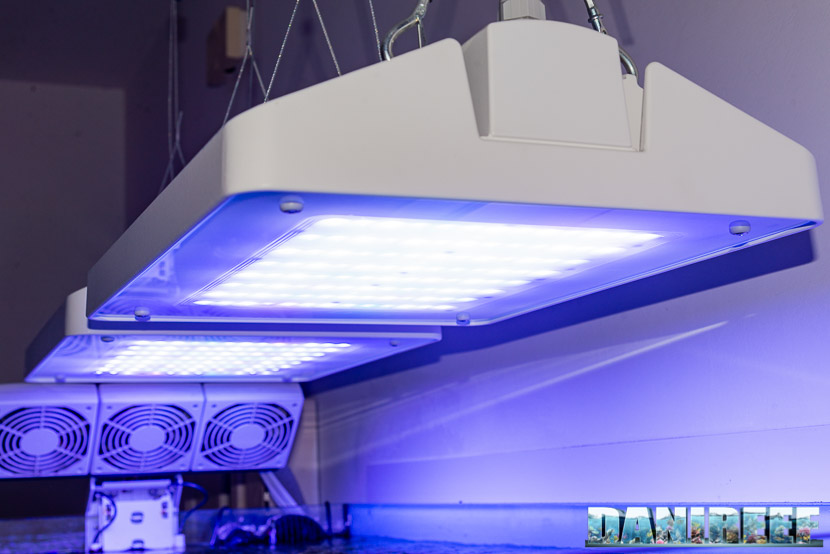
PAR measurement at 17 cm
The test’s setup is straightforward: Below is the chart and the device, above is the ceiling light placed on the aluminum bars.
Here are the collected values: 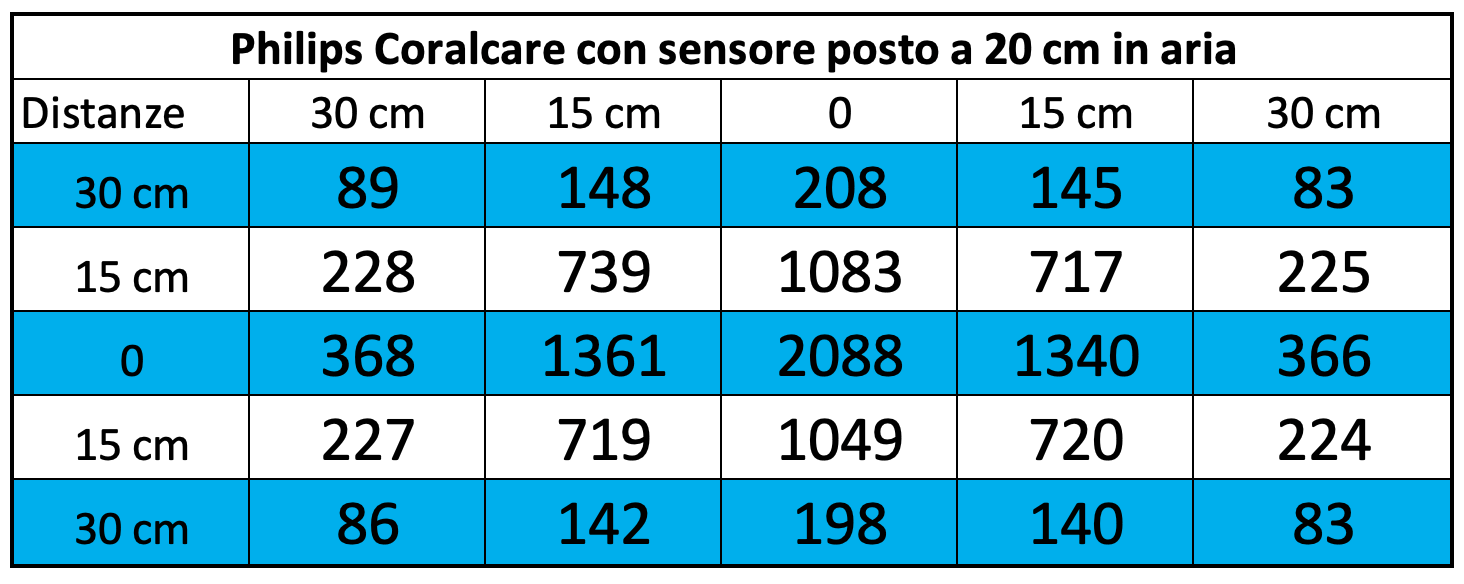
And for the corresponding chart, we will use the same scale for ceiling lights with similar power. 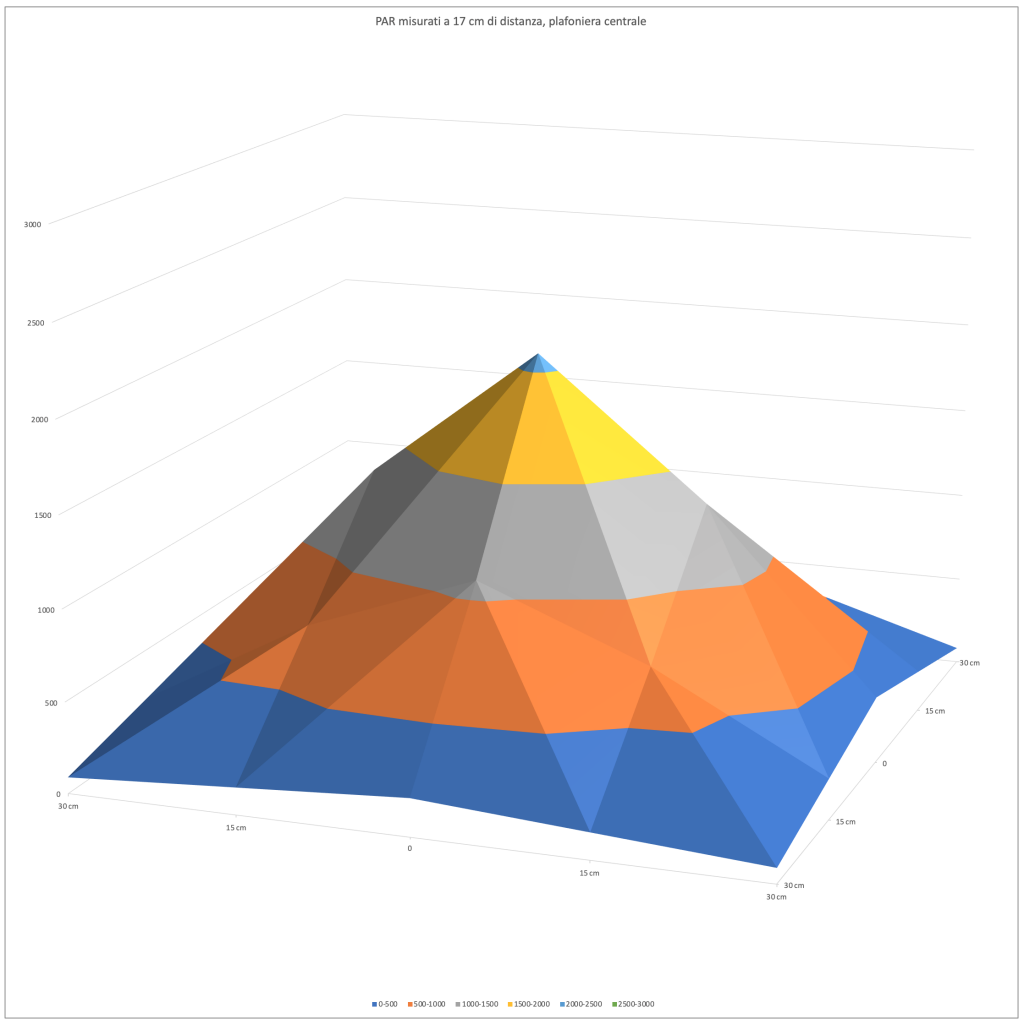
Because the ceiling light was very close to the sensor, the PAR quickly decreased on the sides. But the chart (embracing an area of 60×60 cm) will show its usefulness when we will compare different ceiling lights.
PAR measurement at 37 cm
Here are the collected values: 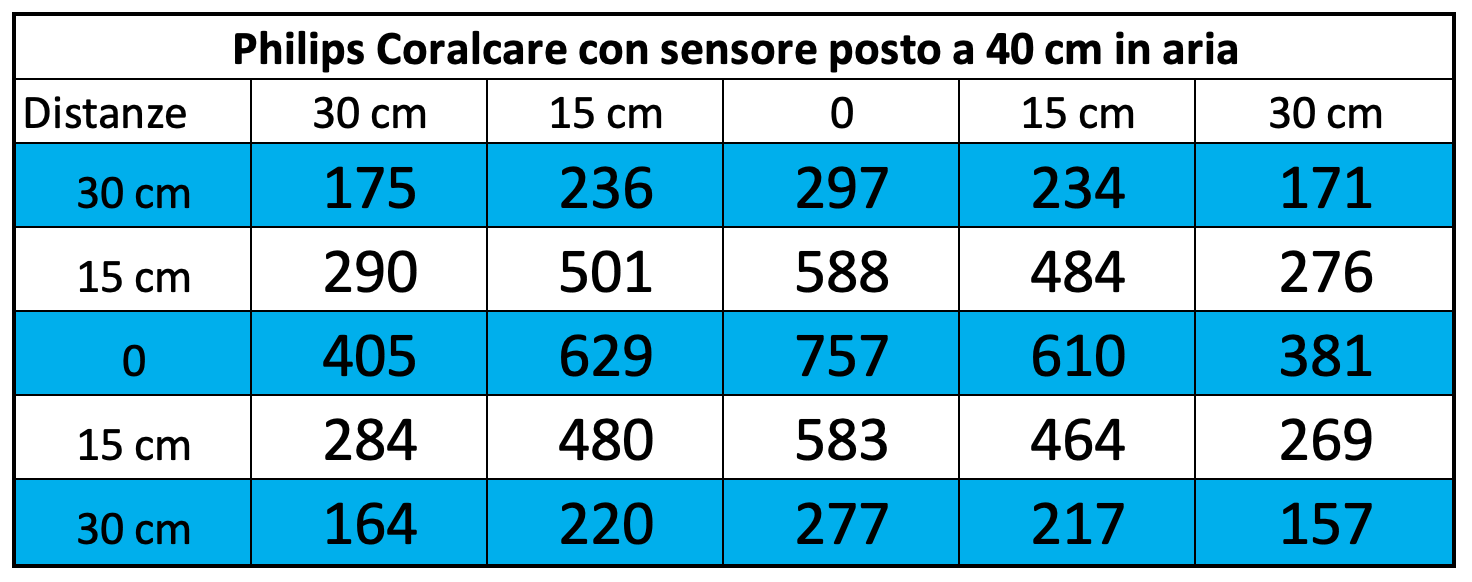
And for the corresponding chart we will use the same scale for ceiling lights with similar power. 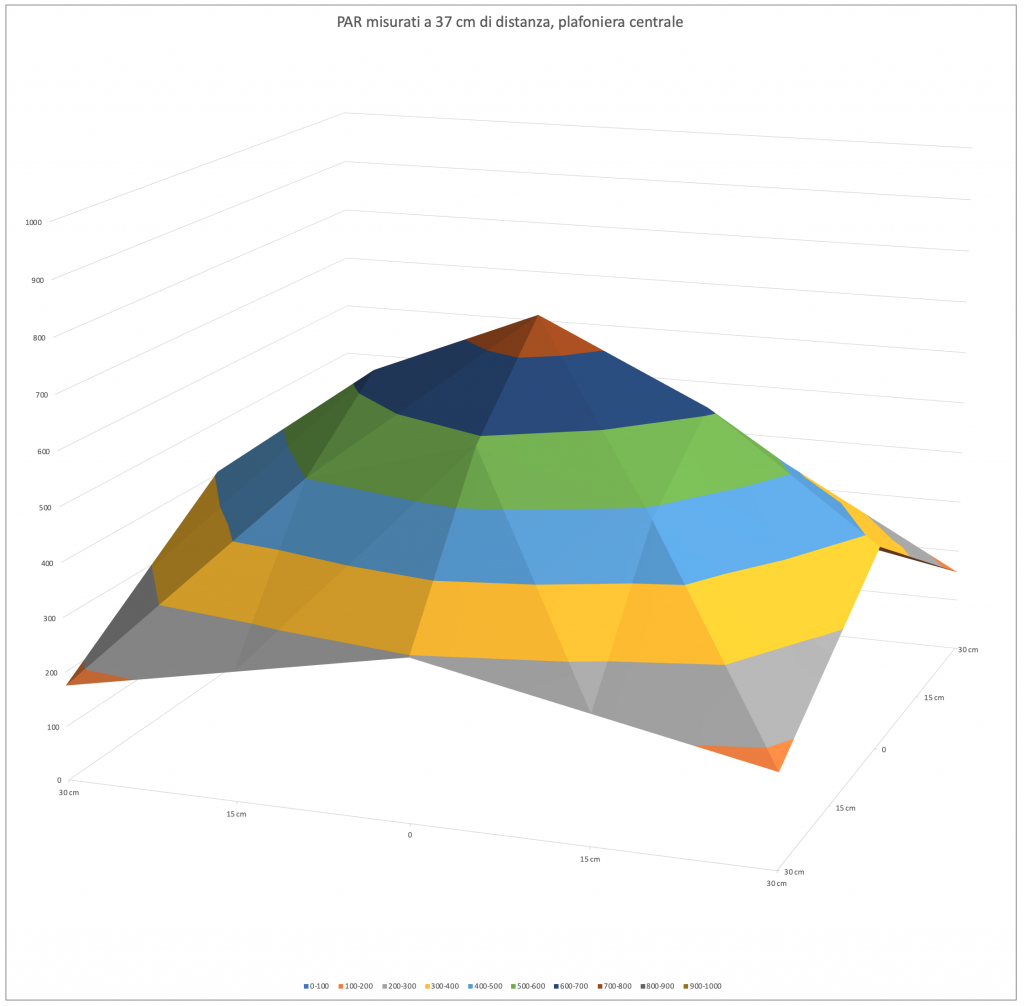
A larger distance between the ceiling lights and sensor decreases the difference between PAR in the middle and on the sides. The light spreads, but the central value decreases from 2088 to 757 μmol m-2 s-1.
PAR measurement at 57 cm
Here are the collected values: 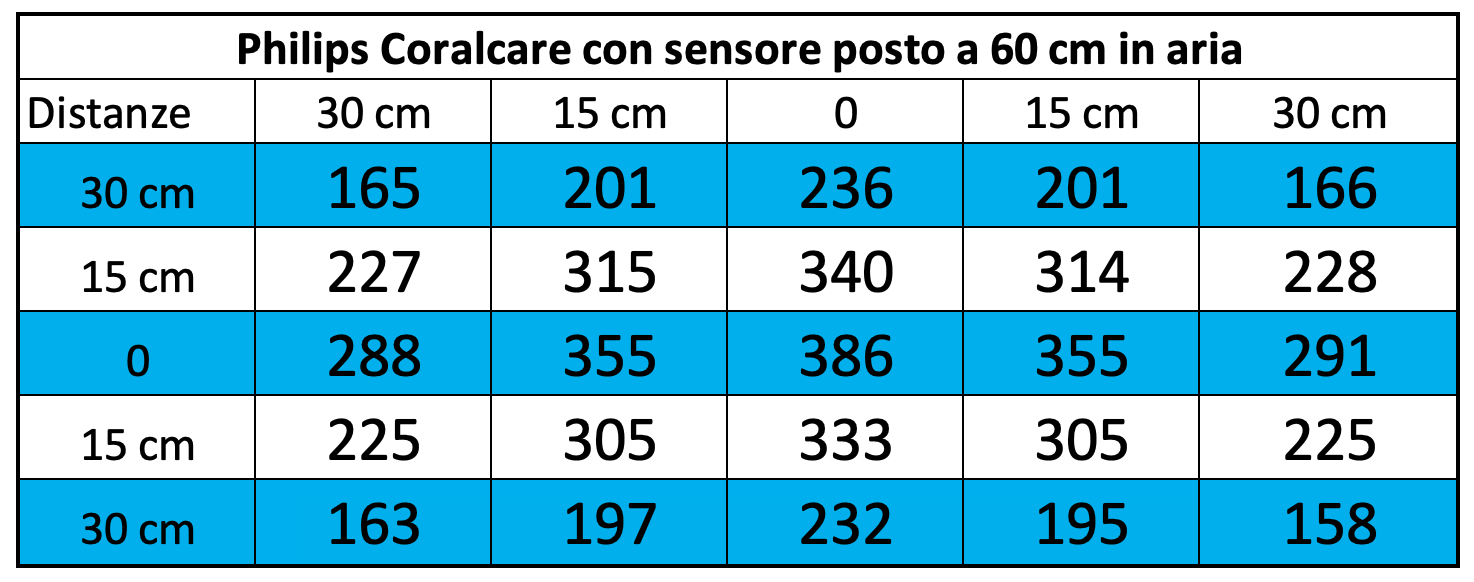
And for the corresponding chart we use the same scale for ceiling lights with similar power. 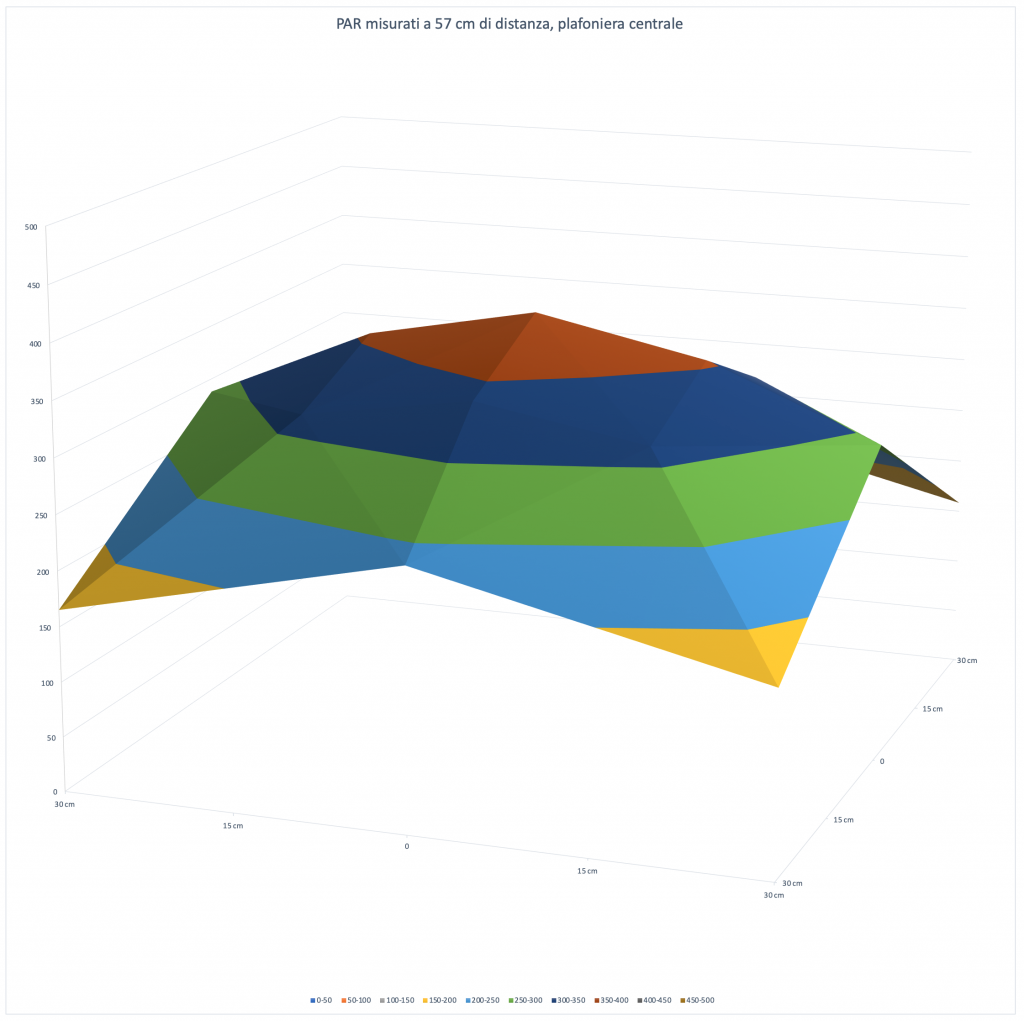
Increasing the space between the ceiling light and sensor decreases the difference between PAR in the middle and on the sides. We have more uniformity, as expected. The light spreads, but the central value decreases from 2088 to 757 and to 386 μmol m-2 s-1.
The PAR in the middle of the different configurations
Let’s continue with our technical measurements. We can see below how the PAR collected in the middle decreases with the three different distances.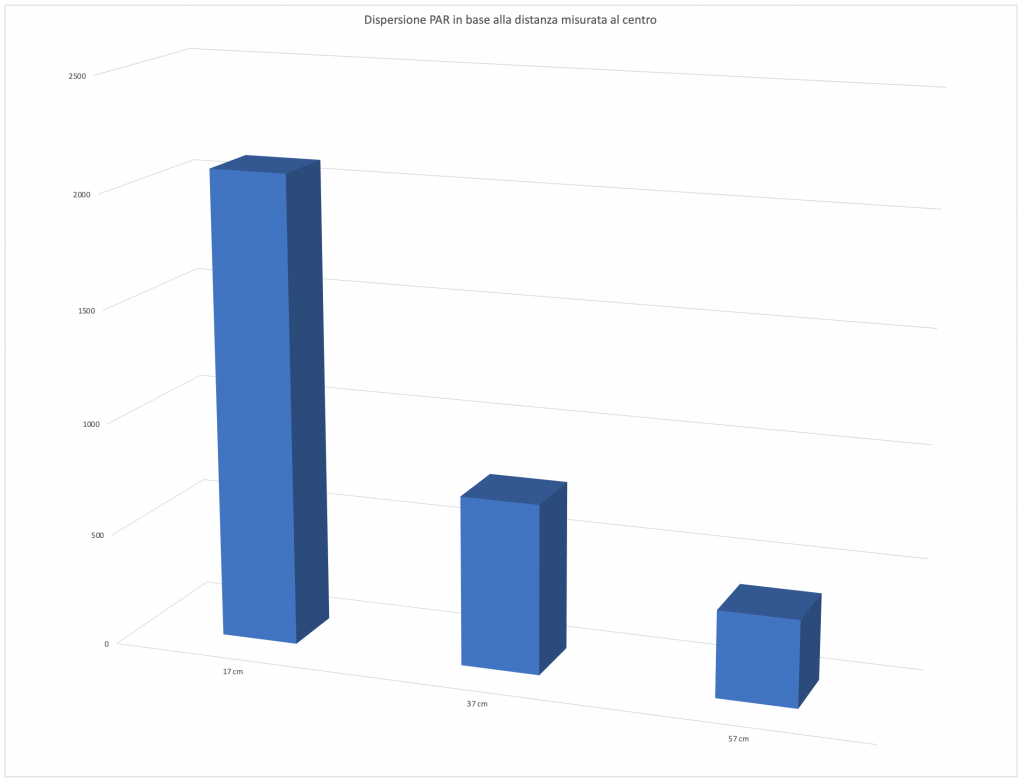
Energy variations depending on the distance
I think this is the most significant data: the energy variation. I calculated the volumes under the three curves, as it’s obvious that moving away from the ceiling light decreases the PAR. In this way you can compare all the light energy contained in the 60×60 cm area illuminated by the ceiling light. The three values: 1,858,572; 1,340,533; and 933,246; aren’t so different when you consider the value in the middle.
Values per channel in the middle in the three distances
We also measured the values per each channel, but only in the middle, in order to give you an idea of the contribution of the different channels on the PAR produced. 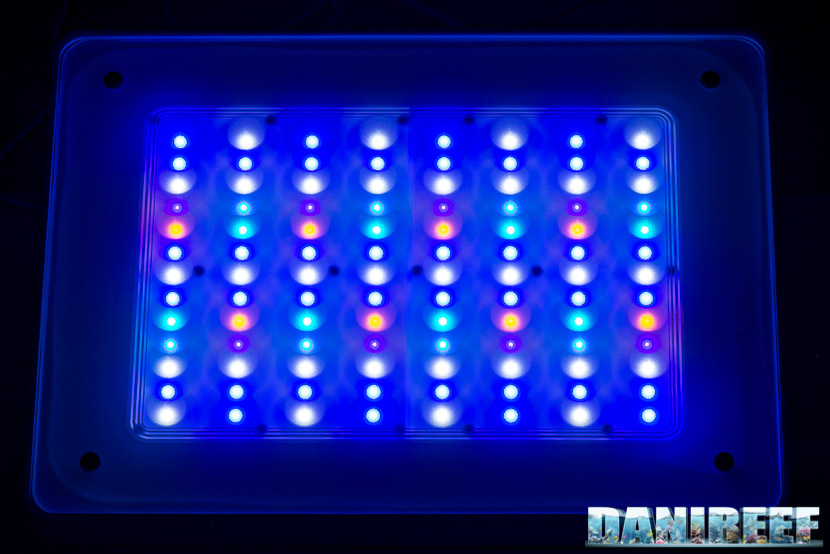
Pictured above is the Philips CoralCare with all the LEDs turned on. 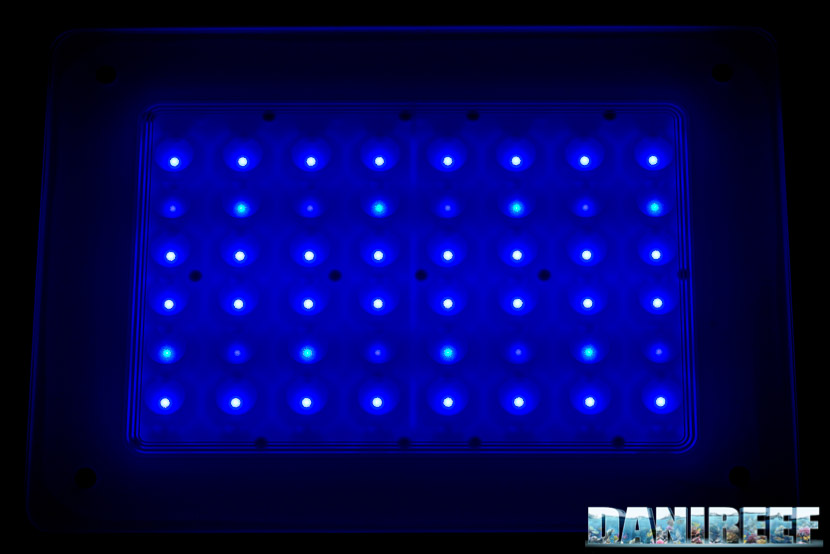
Above is just the blue channel. 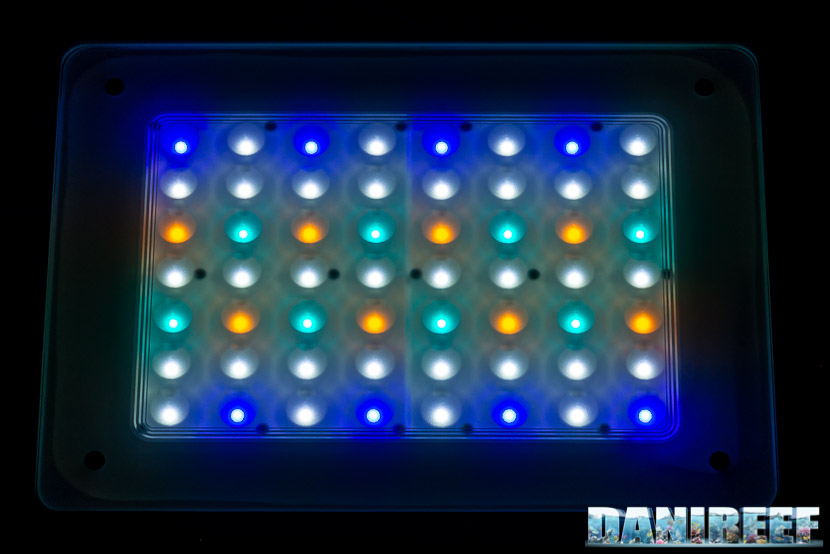
And now the white channel, with some blues.
Here are the collected values:
| Distance = 17 cm | Distance = 37 cm | Distance = 57 cm | |
| Blue channel | 960 μmol m-2 s-1 | 345 μmol m-2 s-1 | 175 μmol m-2 s-1 |
| White channel | 1118 μmol m-2 s-1 | 414 μmol m-2 s-1 | 213 μmol m-2 s-1 |
The white channel has a higher PAR number than the blue channel, about 20%.
Consumption
We measured the consumption with the useful RCE PM600, which can also measure the Cos(fi) (or power factor). The result is already given in watts.
Here is how we calculated the absorbed current (the power):
Ceiling lights Philips CoralCare: 190.50 watt. Considering that at 17 cm the ceiling light has at the middle 2.088 μmol m-2 s-1, we can guess that it will have a peak value of 10.96 μmol m-2 s-1 w-1 (PAR per watt). The same value of the declared 190 w.
The cos(fi) is the same as what was declared: 0.98 
Maintenance Costs
The Philips CoralCare costs 749 euro ($827.75 USD).
The absorbed power is 190.5 watt, so the relationship cost/watt is about 3.93 euro per watt. One of the best values we have ever measured.
The comparison with the other ceiling lights on the market
We have started to use the new Quantum Meter MQ-510 di Apogee. we can’t completely compare the data of other ceiling lights, as we previously used the Seneye probe. The CoralCare is the first ceiling light to which we applied this method, so we will add many new comparisons in the next weeks. We have already measured the values of the Cetus 2, the Aqamai LRM, and the LRS. In addition, we have to think about the CoralCare as a ceiling light with diffused light, like the Orphek Atlantik V4, which we will soon test again with the new method, the GNC 466, and the Maxspect Ethereal. The Orphek registered 1,515 PAR, the GNC 696 PAR, and the Ethereal 689 PAR.
Remember that the PAR measurements were taken at 20 cm distance in air (about 17 cm real distance)
| Ceiling light | PAR | Watt | Price | PAR/watt | euro per watt |
| GNC 466 | 696 (Seneye) | 120 | 1.400 euro | 5,8 spread | 11,7 |
| Orphek Atlantik V4 | 1.515 (Apogee) | 226 | 1.099 euro | 6,7 spread | 4,9 |
| Philips CoralCare 2018 | 2.088 (Apogee) | 190 | 749 euro | 11 spread | 3,9 |
| Maxspect Ethereal | 689 (Seneye) | 130 | 500 euro | 5,3 semi spread | 3,8 |
| Led bars Askoll Pure Marine | 237 (Apogee) | 28 | n.d. | 8,4 | |
| Zetlight UFO ZE-8000 | 791 (Seneye) | 91,5 | 500 euro | 8,6 cluster | 5,5 |
| Aqamai LRM | 1.088 (Seneye) | 87,5 | 465 euro | 12,4 double cluster | 5,2 |
 The Philips CoralCare 2018 registered the highest value we have ever seen. The best PAR per watt value was the Apogee. In term of price they’re still the best, second only to the Maxspect Ethereal.
The Philips CoralCare 2018 registered the highest value we have ever seen. The best PAR per watt value was the Apogee. In term of price they’re still the best, second only to the Maxspect Ethereal.
Maintanence costs
The absorbed power is 190 watts, so it has a cost/watt of about 3,9 euro per watt. In order to make a comparison with the orher ceiling lights you can refer to this chart:
| Ceiling light | Price | Consumption | Relationship euro per watt | |
| Philips Coralcare 2018 | 749 euro | 190 watt | 3,9 euro per watt | |
| Maxspect Ethereal | 500 euro | 126 watt | 4,0 euro per watt | |
| radion XR30w G2 PRO | 790 euro | 170 watt | 4,7 euro per watt | |
| radion XR30w G4 PRO | 915 euro | 190 watt | 4,8 euro per watt | |
| OceanLed Sunrise 600 | 870 euro | 180 watt | 4,8 euro per watt | |
| Orphek Atlantik V4 | 1099 euro | 226 watt | 4,9 euro per watt | |
| radion XR30w G2 | 690 euro | 140 watt | 4,9 euro per watt | |
| radion XR30w G4 | 760 euro | 150 watt | 5,1 euro per watt | |
| Aqamai LRM | 465 euro | 87,5 watt | 5,2 euro per watt | |
| Zetlight UFO ZE-8000 | 500 euro | 91,5 watt | 5,5 euro per watt | |
| CEAB Slide & Led | 2.700 euro | 275 watt | 9,8 euro per watt | |
| sicce GNC 466 | 1.592 euro | 120 watt | 13,3 euro per watt |
.
The ceiling light is very well built; it’s not so beautiful, but the covering is almost perfect and the application is very simple. The PAR is perfect for every coral within an area of 60×60 cm, but the covering can easily reach 80×80 cm. The cost per watt is the best among the measured ones and the PAR expressed is impressive. What else do you need?
Questions and comments, as always, are welcomed. And most of all, do you like our new measuring method? [Translated by Agnese Poggi]
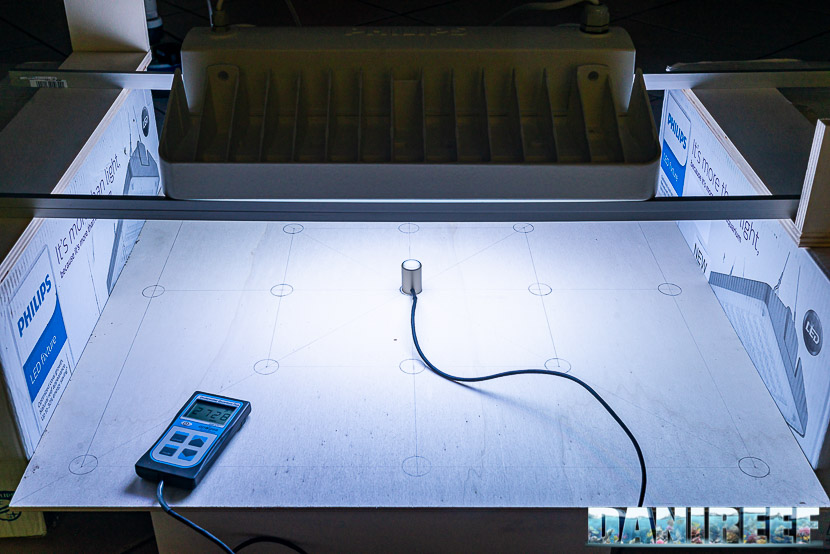 The first time we saw the new Philips CoralCare was at Interzoo 2016; we immediately liked it and we have been lucky to be able to have one in our aquarium.
The first time we saw the new Philips CoralCare was at Interzoo 2016; we immediately liked it and we have been lucky to be able to have one in our aquarium.
At Interzoo of 2018 we saw the new version of the Philips CoralCare ceiling lights (article), with a new, slightly different LED color spectrum, more blue-leaning, as many aquarists had asked for.
Technical characteristics of the Philips CoralCare 2018
Each ceiling light has 104 LEDs, the same as the older version. The absorbed power declared is 190 watts. Obviously, the LEDs are all Philips Lumileds and they’re distributed in this way (the old configuration is in parenthesis):
- 32 Luxeon TX 6500K/70 (before 40);
- 40 Luxeon T Royal Blue (before 32);
- 8 Luxeon UV 420nm (before 16);
- 8 Luxeon Rebel Cyan;
- 8 Luxeon Rebel Phosphor Converted Amber;
- 8 Luxeon Z Blue (there were none).
The two channels in which they are distributed are as follows:
Channel 1:
- 32 Luxeon T Royal Blue;
- 8 Luxeon UV 420nm (before 16);
- 8 Luxeon Z Blue (there were none).
Channel 2:
- 32 Luxeon TX 6500K/70;
- 8 Luxeon Rebel Cyan;
- 8 Luxeon Rebel Phosphor Converted Amber;
- 8 Luxeon T Royal Blue (there were none).
Dimensions
- Length: 45 cm
- Width: 35 cm
- Height: 13 cm
- Weight: 10 kg
Selling price: 749 euro ($827.75 USD)
Another difference from the previous version is the option to have the external shell in black or white. As you can see from the pictures, I chose the white ones. In the following picture you can see the different colorations on display at last year’s Interzoo, though the colors don’t stand out particularly because of the blue light. 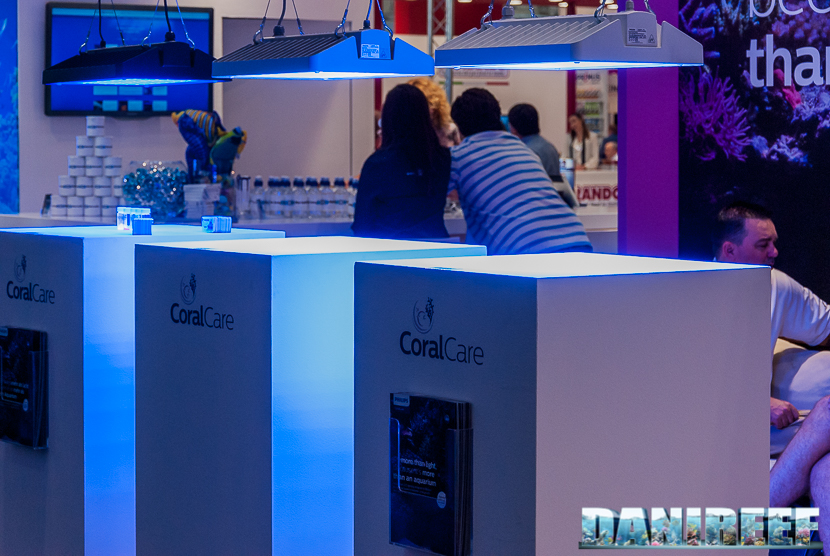
The duration
Philips guarantees a long lasting duration for its ceiling light. The LEDs (of 3 or 5 watts) are powered by a very low current in order to achieve over 25,000 hours of work. The specs says that if used in a place with temperatures under 35 degrees C (95 degrees F), at 100% of their power, 90% of the ceiling lights, after 25,000 hours, would still have 80% of their original power. Any change in those conditions will increase or decrease their duration. The average use of my ceiling light, for example, is 12 hours at a time, but never at their maximum power. It should be equal to using it 4 hours a day at 100%. This would be about 6,249 days of use, almost 18 years. Considering that my house will never be 35 degrees, we won’t have to worry about the light for a really long time.
Construction
The Philips CoralCare is excellently built, even if the design isn’t among the most appreciated, especially in Italy. But we have to remember that the power supply for the ceiling light is inside the shell. This has two repercussions: first, we don’t have to think about placing or installing it, and second, the light will work best in an open space where the heat can easily dissipate. 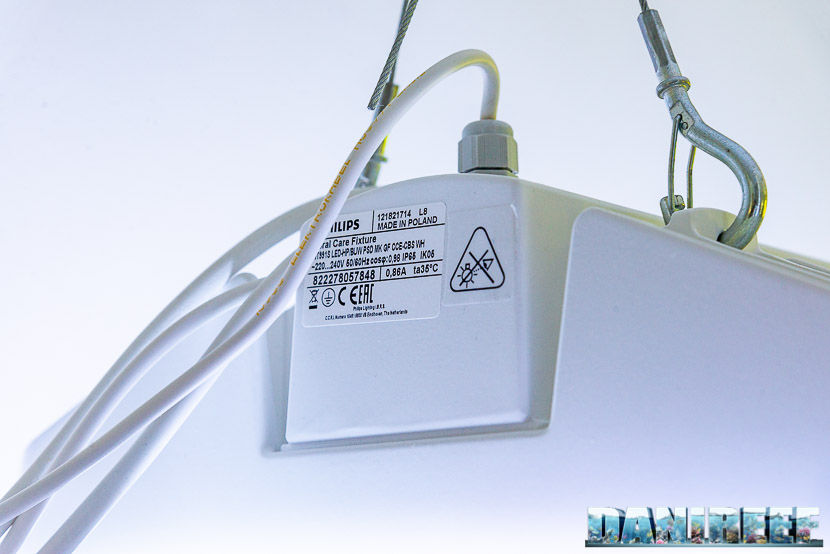
The programming
The software is available both for windows and mac, but it doesn’t work with WiFi, so you can’t use a smartphone or tablet. But this can actually be seen as an advantage: the programming never jams. You insert the USB cable in the computer and start the app; it works 100% of time.
The software was designed to give the two LED channels very specific limits. It’s not possible to make weird or strange combinations, which protects the corals.
There aren’t any moon phases, and the minimum brightness is too high for night use. In addition, you aren’t able to set a period of acclimation. But we’re talking about distributed light, so this shouldn’t be a real problem.

The programming is extremely simple, and I really mean extremely. Having the security of not doing anything bad is priceless, for a certain type of user. You set the beam on cold and warm colors, you can set the intensity and the time, and helped by the chart, you can create the perfect setting.
For example, pictured above you can see my actual setting. It starts at 11:00 am with just the blue light and at 11:30 am the white light also switches on. At noon it increases the white light until it reaches its maximum intensity at 4:30 pm. And then it decreases, with a bit of residual light, until 10:30 pm.
Our new working method for the PAR measurement
During the long nights spent on our forum we always wondered how could we compare PAR from different ceiling lights. Even though we had the perfect device, the Quantum Meter MQ-510 di Apogee, we could only compare measurements taken at the center, at 20 cm away.
The Quantum Meter MQ-510 measures the PAR, expressed in PFFD (photosynthetic photon flux density) in μmol m-2 s-1. This device is calibrated to work underwater, so if it’s in the air, the measured value has to be divided by 1.32: the dive factor. We did all necessary conversions. The values that follow are correct. 
We decided to make a square base of 70×70 cm and then establish 17 fiducial points where we’d place the Quantum Meter MQ-510; we also made lifts of 20, 40, and 60 cm for the ceiling light, to have the same distance from the sensor. This will allow us to create curves in the space that can be compared to those of other ceiling lights, all at the same distances. This distance is measured from the base of the sensor to the ceiling light. Really, it should be decreased by 3.5 cm, which is the height of the measurement cylinder. 
The three measurements are made at 17, 37, and 57 cm away. Because they’re done in air they will be corrected. 
PAR measurement at 17 cm
The test’s setup is straightforward: Below is the chart and the device, above is the ceiling light placed on the aluminum bars.
Here are the collected values: 
And for the corresponding chart, we will use the same scale for ceiling lights with similar power. 
Because the ceiling light was very close to the sensor, the PAR quickly decreased on the sides. But the chart (embracing an area of 60×60 cm) will show its usefulness when we will compare different ceiling lights.
PAR measurement at 37 cm
Here are the collected values: 
And for the corresponding chart we will use the same scale for ceiling lights with similar power. 
A larger distance between the ceiling lights and sensor decreases the difference between PAR in the middle and on the sides. The light spreads, but the central value decreases from 2088 to 757 μmol m-2 s-1.
PAR measurement at 57 cm
Here are the collected values: 
And for the corresponding chart we use the same scale for ceiling lights with similar power. 
Increasing the space between the ceiling light and sensor decreases the difference between PAR in the middle and on the sides. We have more uniformity, as expected. The light spreads, but the central value decreases from 2088 to 757 and to 386 μmol m-2 s-1.
The PAR in the middle of the different configurations
Let’s continue with our technical measurements. We can see below how the PAR collected in the middle decreases with the three different distances.
Energy variations depending on the distance
I think this is the most significant data: the energy variation. I calculated the volumes under the three curves, as it’s obvious that moving away from the ceiling light decreases the PAR. In this way you can compare all the light energy contained in the 60×60 cm area illuminated by the ceiling light. The three values: 1,858,572; 1,340,533; and 933,246; aren’t so different when you consider the value in the middle.
Values per channel in the middle in the three distances
We also measured the values per each channel, but only in the middle, in order to give you an idea of the contribution of the different channels on the PAR produced. 
Pictured above is the Philips CoralCare with all the LEDs turned on. 
Above is just the blue channel. 
And now the white channel, with some blues.
Here are the collected values:
| Distance = 17 cm | Distance = 37 cm | Distance = 57 cm | |
| Blue channel | 960 μmol m-2 s-1 | 345 μmol m-2 s-1 | 175 μmol m-2 s-1 |
| White channel | 1118 μmol m-2 s-1 | 414 μmol m-2 s-1 | 213 μmol m-2 s-1 |
The white channel has a higher PAR number than the blue channel, about 20%.
Consumption
We measured the consumption with the useful RCE PM600, which can also measure the Cos(fi) (or power factor). The result is already given in watts.
Here is how we calculated the absorbed current (the power):
Ceiling lights Philips CoralCare: 190.50 watt. Considering that at 17 cm the ceiling light has at the middle 2.088 μmol m-2 s-1, we can guess that it will have a peak value of 10.96 μmol m-2 s-1 w-1 (PAR per watt). The same value of the declared 190 w.
The cos(fi) is the same as what was declared: 0.98 
Maintenance Costs
The Philips CoralCare costs 749 euro ($827.75 USD).
The absorbed power is 190.5 watt, so the relationship cost/watt is about 3.93 euro per watt. One of the best values we have ever measured.
The comparison with the other ceiling lights on the market
We have started to use the new Quantum Meter MQ-510 di Apogee. we can’t completely compare the data of other ceiling lights, as we previously used the Seneye probe. The CoralCare is the first ceiling light to which we applied this method, so we will add many new comparisons in the next weeks. We have already measured the values of the Cetus 2, the Aqamai LRM, and the LRS. In addition, we have to think about the CoralCare as a ceiling light with diffused light, like the Orphek Atlantik V4, which we will soon test again with the new method, the GNC 466, and the Maxspect Ethereal. The Orphek registered 1,515 PAR, the GNC 696 PAR, and the Ethereal 689 PAR.
Remember that the PAR measurements were taken at 20 cm distance in air (about 17 cm real distance)
| Ceiling light | PAR | Watt | Price | PAR/watt | euro per watt |
| GNC 466 | 696 (Seneye) | 120 | 1.400 euro | 5,8 spread | 11,7 |
| Orphek Atlantik V4 | 1.515 (Apogee) | 226 | 1.099 euro | 6,7 spread | 4,9 |
| Philips CoralCare 2018 | 2.088 (Apogee) | 190 | 749 euro | 11 spread | 3,9 |
| Maxspect Ethereal | 689 (Seneye) | 130 | 500 euro | 5,3 semi spread | 3,8 |
| Led bars Askoll Pure Marine | 237 (Apogee) | 28 | n.d. | 8,4 | |
| Zetlight UFO ZE-8000 | 791 (Seneye) | 91,5 | 500 euro | 8,6 cluster | 5,5 |
| Aqamai LRM | 1.088 (Seneye) | 87,5 | 465 euro | 12,4 double cluster | 5,2 |
 The Philips CoralCare 2018 registered the highest value we have ever seen. The best PAR per watt value was the Apogee. In term of price they’re still the best, second only to the Maxspect Ethereal.
The Philips CoralCare 2018 registered the highest value we have ever seen. The best PAR per watt value was the Apogee. In term of price they’re still the best, second only to the Maxspect Ethereal.
Maintanence costs
The absorbed power is 190 watts, so it has a cost/watt of about 3,9 euro per watt. In order to make a comparison with the orher ceiling lights you can refer to this chart:
| Ceiling light | Price | Consumption | Relationship euro per watt | |
| Philips Coralcare 2018 | 749 euro | 190 watt | 3,9 euro per watt | |
| Maxspect Ethereal | 500 euro | 126 watt | 4,0 euro per watt | |
| radion XR30w G2 PRO | 790 euro | 170 watt | 4,7 euro per watt | |
| radion XR30w G4 PRO | 915 euro | 190 watt | 4,8 euro per watt | |
| OceanLed Sunrise 600 | 870 euro | 180 watt | 4,8 euro per watt | |
| Orphek Atlantik V4 | 1099 euro | 226 watt | 4,9 euro per watt | |
| radion XR30w G2 | 690 euro | 140 watt | 4,9 euro per watt | |
| radion XR30w G4 | 760 euro | 150 watt | 5,1 euro per watt | |
| Aqamai LRM | 465 euro | 87,5 watt | 5,2 euro per watt | |
| Zetlight UFO ZE-8000 | 500 euro | 91,5 watt | 5,5 euro per watt | |
| CEAB Slide & Led | 2.700 euro | 275 watt | 9,8 euro per watt | |
| sicce GNC 466 | 1.592 euro | 120 watt | 13,3 euro per watt |
.
The ceiling light is very well built; it’s not so beautiful, but the covering is almost perfect and the application is very simple. The PAR is perfect for every coral within an area of 60×60 cm, but the covering can easily reach 80×80 cm. The cost per watt is the best among the measured ones and the PAR expressed is impressive. What else do you need?
Questions and comments, as always, are welcomed. And most of all, do you like our new measuring method? [Translated by Agnese Poggi]

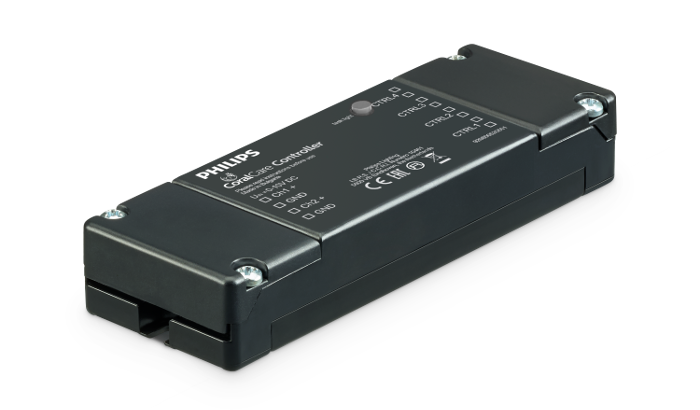
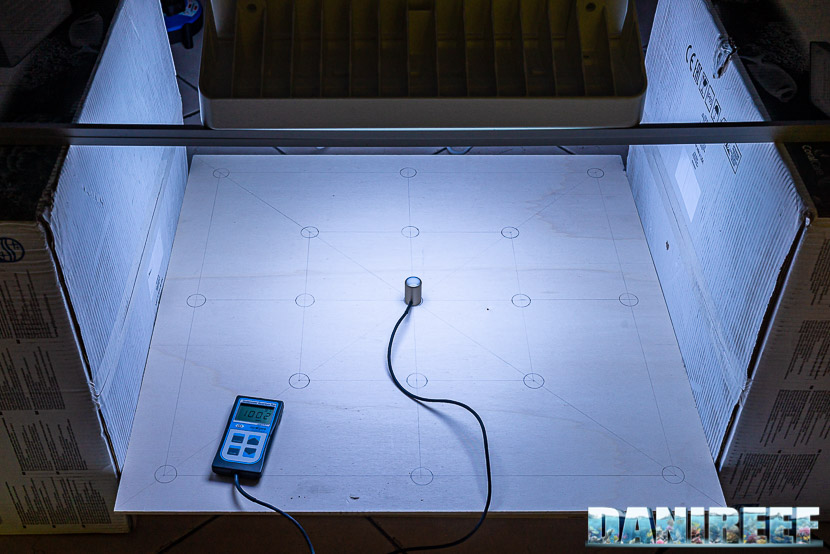
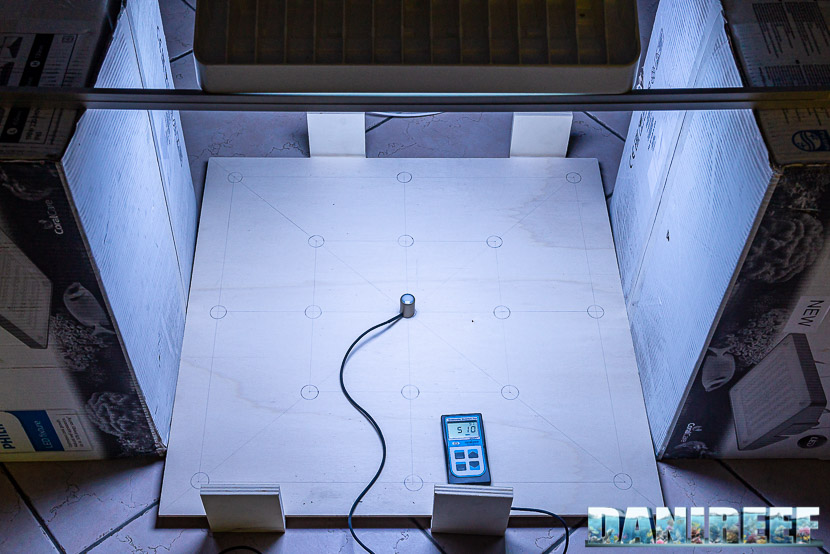
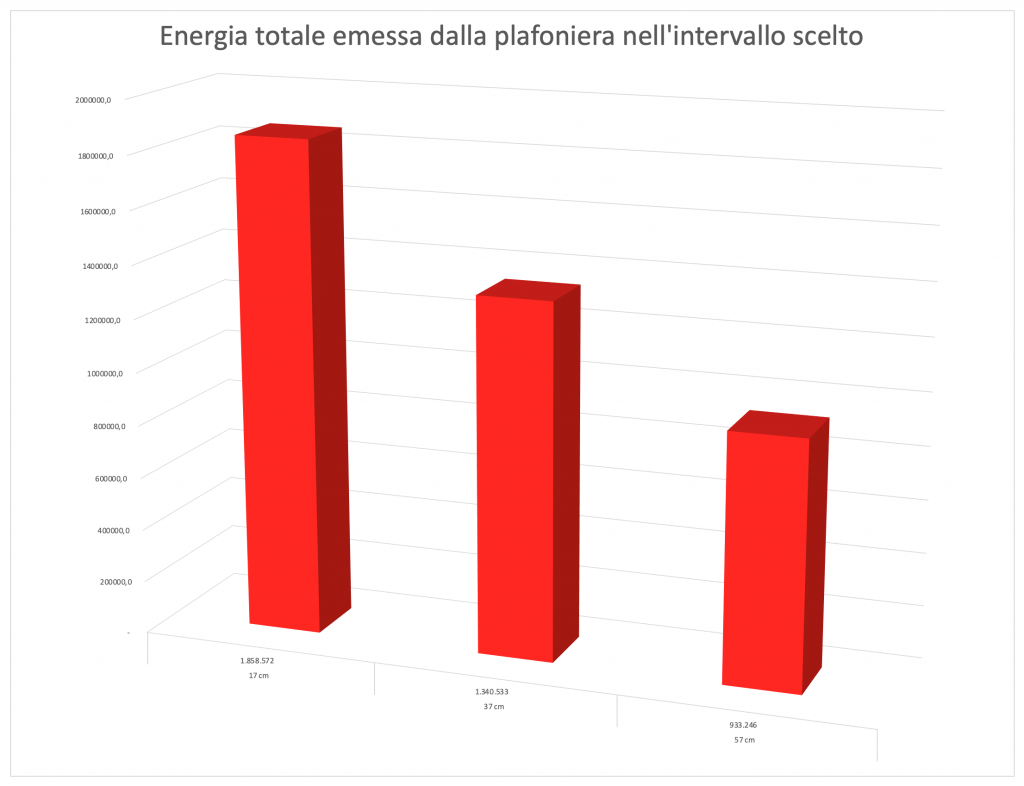
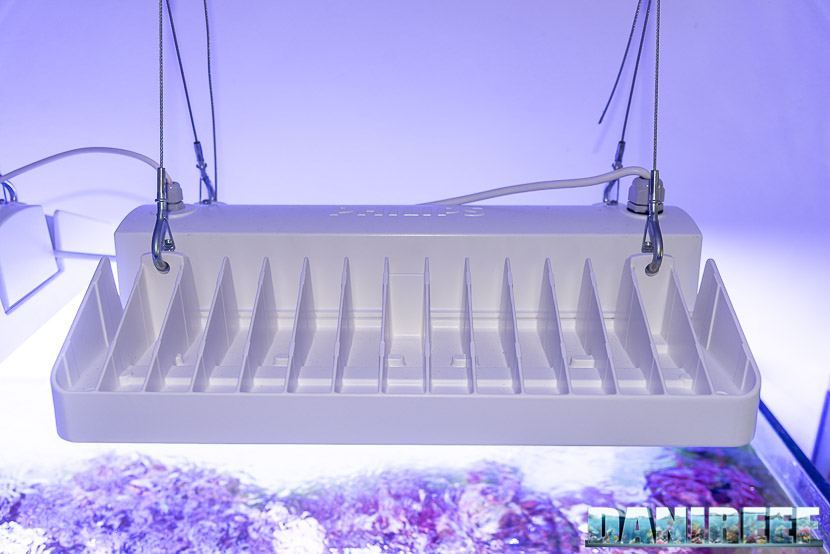
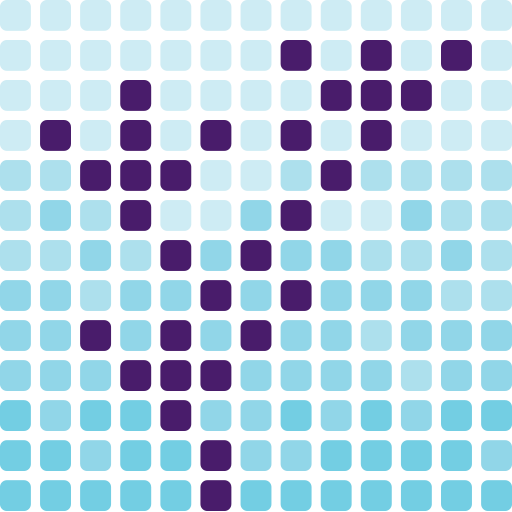

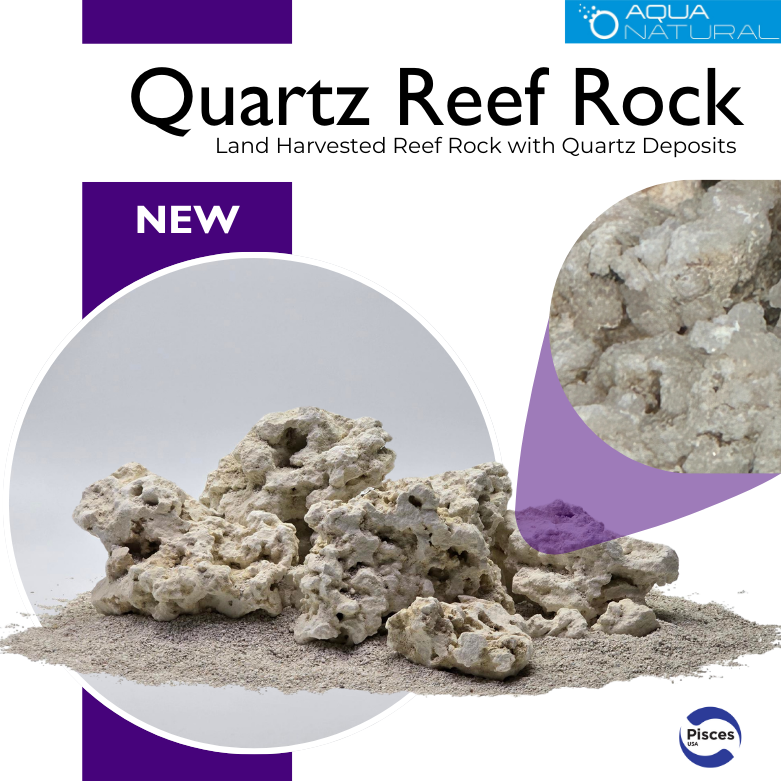

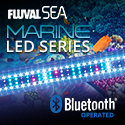
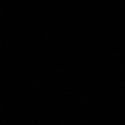


0 Comments